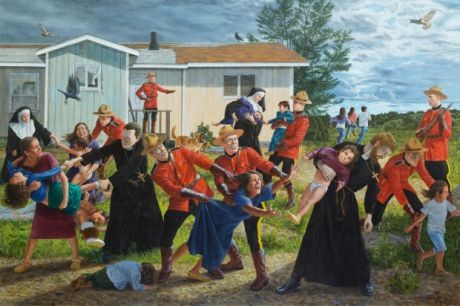Arts
You are here
Shame and Prejudice: A Story of Resilience

March 18, 2017
“I could not think of any history paintings that conveyed or authorized Indigenous experience into the canon of art history. Where were the paintings from the nineteenth century that recounted, with passion and empathy, the dispossession, starvation, incarceration and genocide of Indigenous people here on Turtle Island? Could my own paintings reach forward a hundred and fifty years to tell our history of the colonization of our people.”
Cree artist and filmmaker Kent Monkman wrote this in the foreword to the booklet that accompanies his fabulous exhibit “Shame and Prejudice: A Story of Resilience.” And, yes, his art absolutely captures the impact of colonization.
His style is unique among Indigenous painters, with attention to the urban environment and historical “white” settings. The paintings are never devoid of the natural world, though, with numerous depictions of trees, birds, bears and other animals within his cityscapes, in works that explore violence, despair, addiction and humour. The last is partly achieved through the use of his drag queen persona, Miss Chief (ok full name Miss Chief Eagle Testickle). As Monkman explains “A gender-bending time traveller, Miss Chief lives in the past, present and future. She embodies the flawed and playful trickster spirit, teasing out the truths behind false histories and cruel experiences.”
The exhibit, now touring Canada and Quebec, features nine chapters covering the time from the settlement of New France to the modern day “Urban Res.”
In a surprisingly positive review (coming from Maclean’s magazine that is) can be found the following description of Monkman’s send-up of the famous scene of “The Fathers of Confederaion”: “You’ll find Miss Chief, lover of Louis Vuitton and pink heels, in, for example, a cheeky send-up of Robert Harris’s famed portrait of the Fathers of Confederation. She’s nude, seated facing them, her legs akimbo. The men look on in horror, and in lust. He called it The Daddies.”
But there also are very moving depictions of children being torn away from their parents to be taken to residential schools, or the violence of urban gangs, or commonplace hunger and poverty.
At a time when the Trudeau government is bent on “celebrating” 150 years of confederation, the Monkman exhibit is a beautiful and necessary reminder of the crimes handed down by the Canadian state to the many Indigenous peoples who inhabited this land.
For examples of his art, see http://canadianart.ca/artists/kent-monkman/
For info on the touring exhibit, see http://www.kentmonkman.com/
Section:










